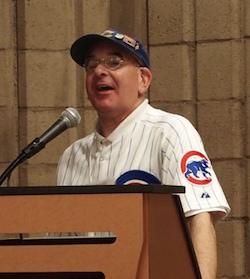Opinion analysis: Standing, intervention and a narrow disposition

on Jun 5, 2017 at 2:14 pm
Asked to decide whether an intervenor-of-right must show Article III standing, a unanimous Supreme Court in Town of Chester v. Laroe Estates today seized on the narrowest point of agreement among the parties and the United States as amicus curiae to answer the question in the affirmative and return the case to the lower court to perform the critical analysis, all in a compact eight pages-plus-four-lines.
In 2001, the late land-developer Steven Sherman purchased 400 acres of land in the town of Chester, New York, with the intent of building a housing subdivision called MareBrook. His plan ran into the town’s “ever-changing labyrinth of red tape” that pushed Sherman to the brink of personal bankruptcy. In 2003, Sherman received $6 million in payments from Laroe Estates, secured by a mortgage on the development and an agreement to sell Laroe some parcels upon approval of Marebrook; Laroe paid more than $2.5 million of that promised $6 million. The property ultimately was foreclosed on by TD Bank, although the agreement between Laroe and Sherman remained in effect.
In 2012, Sherman sued the town of Chester in state court on a host of federal and state claims, including for a regulatory taking; the town removed the case to federal district court and the case took one trip to the U.S. Court of Appeals for the 2nd Circuit. On remand to the federal district court, Laroe moved to intervene as of right. It argued that it was the equitable owner of the property at issue in Sherman’s action, which gave it an interest in that property; that its interest would be impaired by Sherman’s lawsuit; and that Sherman did not adequately represent Laroe’s interests because Sherman had his own litigation agenda. Laroe filed an intervenor’s complaint asserting a regulatory-takings claim substantially identical to Sherman’s, seeking a judgment in its favor against the town and an award of damages to Laroe as “compensation for the taking of Laroe’s interest” in the property. The Supreme Court granted certiorari to decide whether an intervenor-of-right such as Laroe must have Article III standing.
The court began by reciting the basic and well-known requirements of standing — a party must show it has suffered a concrete injury-in-fact that is fairly traceable to the defendant’s conduct and can be redressed by a judicial remedy — and its separation-of-powers foundations. It then stated that “standing is not dispensed in gross.” One plaintiff must show standing for each claim and each form of relief sought. When there are multiple plaintiffs, at least one must have standing to seek each form of relief requested in the complaint. And the same principle applies to anyone asserting a claim or seeking relief – “[f]or all relief sought, there must be a litigant with standing, whether that litigant joins the lawsuit as a plaintiff, a coplaintiff, or an intervenor of right,” at least when the intervenor “seeks additional relief beyond that which the plaintiff requests.” An intervenor and a plaintiff seek different relief when each seeks a separate money judgment in its own name.
The problem in this case, the court observed, is that “[i]t is unclear whether Laroe seeks the same relief as Sherman or different relief, such as a money judgment against the town in Laroe’s own name.” Laroe’s intervenor complaint requested a judgment against the town awarding damages directly to it. But Laroe’s papers and arguments were inconsistent on this point before the court of appeals. “Taken together,” the court said, “these representations at best leave it ambiguous whether Laroe is seeking damages for itself or is simply seeking the same damages sought by Sherman.”
But, the court stated, “the Court of Appeals did not resolve this ambiguity,” and it directed the lower court to dispel that confusion by determining whether Laroe wants its own money judgment against the town. If it does, “it seeks damages different from those sought by Sherman and must establish its own Article III standing in order to intervene.” The 2nd Circuit then must decide, for the first time, whether Laroe has standing, given its equitable interest in the property.
The court’s narrow decision did not expressly address two issues at the forefront of the briefing and argument in the case, although the result hints at the answers. First, Chester had argued that standing is required whenever an intervenor-of-right wants to engage as a litigant – for example, by taking discovery or filing motions. The court’s focus seemed to reject that position, suggesting that an intervenor need not show standing if its litigation activities do not extend beyond asserting the same claim for the same remedies as the original plaintiff.
Second, as the court emphasized, the parties and the government did not disagree that standing is necessary when the intervenor seeks different relief. But they did disagree about whether the standing inquiry must be resolved at the threshold in every case or only at the point in the litigation when it becomes clear that the intervenor is bringing a different claim or seeking different relief. They also disagreed about the relationship between Article III standing and the standard for intervention under Rule 24 of the Federal Rules of Civil Procedure – i.e., whether an intervenor could satisfy Rule 24(a) if it did not have standing. The court did not discuss or resolve either point. But given an intervenor’s need to show what it wants to do as intervenor, either in its motion to intervene or in its pleadings, courts should be able to determine early on whether a standing inquiry is needed.


